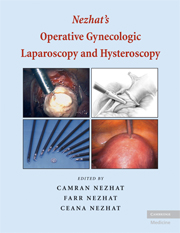Book contents
- Frontmatter
- Contents
- Contributing Authors
- Forewords
- Preface
- 1 HISTORY OF MODERN OPERATIVE LAPAROSCOPY
- 2 EQUIPMENT
- 3 ANESTHESIA
- 4 LAPAROSCOPIC ACCESS
- 5 LAPAROSCOPIC SUTURING
- 6 INTRAPERITONEAL AND RETROPERITONEAL ANATOMY
- 7 FERTILITY
- 8 HYSTEROSCOPY
- 9 MANAGEMENT OF ADNEXAL MASSES
- 10 ENDOMETRIOSIS
- 11 LAPAROSCOPIC ADHESIOLYSIS AND ADHESION PREVENTION
- 12 LEIOMYOMAS
- 13 HYSTERECTOMY
- 14 PELVIC FLOOR
- 15 LAPAROSCOPIC TREATMENT OF CHRONIC PELVIC PAIN
- 16 GYNECOLOGIC MALIGNANCY
- 17 LAPAROSCOPY IN THE PREGNANT PATIENT
- 18 MINIMAL ACCESS PEDIATRIC SURGERY
- 19 LAPAROSCOPIC VASCULAR SURGERY IN 2007
- 20 COMPLICATIONS IN LAPAROSCOPY
- 21 ADDITIONAL PROCEDURES FOR PELVIC SURGEONS
- 22 LAPAROSCOPY SIMULATORS FOR TRAINING BASIC SURGICAL SKILLS, TASKS, AND PROCEDURES
- 23 ROBOT-ASSISTED LAPAROSCOPY
- 24 HYSTEROSCOPY AND ENDOMETRIAL CANCER
- 25 OVERVIEW OF COMPLICATIONS
- Appendix
- Atlas
- Index
6 - INTRAPERITONEAL AND RETROPERITONEAL ANATOMY
Published online by Cambridge University Press: 23 December 2009
- Frontmatter
- Contents
- Contributing Authors
- Forewords
- Preface
- 1 HISTORY OF MODERN OPERATIVE LAPAROSCOPY
- 2 EQUIPMENT
- 3 ANESTHESIA
- 4 LAPAROSCOPIC ACCESS
- 5 LAPAROSCOPIC SUTURING
- 6 INTRAPERITONEAL AND RETROPERITONEAL ANATOMY
- 7 FERTILITY
- 8 HYSTEROSCOPY
- 9 MANAGEMENT OF ADNEXAL MASSES
- 10 ENDOMETRIOSIS
- 11 LAPAROSCOPIC ADHESIOLYSIS AND ADHESION PREVENTION
- 12 LEIOMYOMAS
- 13 HYSTERECTOMY
- 14 PELVIC FLOOR
- 15 LAPAROSCOPIC TREATMENT OF CHRONIC PELVIC PAIN
- 16 GYNECOLOGIC MALIGNANCY
- 17 LAPAROSCOPY IN THE PREGNANT PATIENT
- 18 MINIMAL ACCESS PEDIATRIC SURGERY
- 19 LAPAROSCOPIC VASCULAR SURGERY IN 2007
- 20 COMPLICATIONS IN LAPAROSCOPY
- 21 ADDITIONAL PROCEDURES FOR PELVIC SURGEONS
- 22 LAPAROSCOPY SIMULATORS FOR TRAINING BASIC SURGICAL SKILLS, TASKS, AND PROCEDURES
- 23 ROBOT-ASSISTED LAPAROSCOPY
- 24 HYSTEROSCOPY AND ENDOMETRIAL CANCER
- 25 OVERVIEW OF COMPLICATIONS
- Appendix
- Atlas
- Index
Summary
Sound surgical technique, whether during laparotomy or laparoscopy, is based on accurate anatomic knowledge. Laparoscopic surgeons must adapt to the altered appearance of anatomy due to the effects of pneumoperitoneum, Trendelenburg positioning, and traction from a uterine manipulator. There are inherent limitations of laparoscopy related to the fixed visual axis, loss of depth of field, and magnification. Furthermore, laparoscopes with different angles of view make orientation more challenging.
Because a three-dimensional field is projected to video monitors as a two-dimensional image, it is imperative for the endoscopic surgeon to understand that the anatomic structures appearing superior on the monitor are actually anterior and those inferior are posterior.
In this chapter, we describe some important anatomic relations that are critical during laparoscopic procedures.
SUPERFICIAL INTRAPERITONEAL ANATOMY (LANDMARKS TO RETROPERITONEAL STRUCTURES)
Superficial intraperitoneal landmarks within the pelvis alert the operator to key anatomic structures in the retroperitoneal space (Figure 6.1A—C).
The umbilicus is located at the level of L3—L4, although the location varies with the patient's weight, the presence of abdominal panniculus, and the position of the patient on the operating table (supine vs. Trendelenburg). The abdominal aorta bifurcates at L4–L5 in 80% of cases. [1]
The parietal peritoneum over the anterior abdominal wall is raised at five sites, representing the five umbilical folds.
- Type
- Chapter
- Information
- Publisher: Cambridge University PressPrint publication year: 2008

